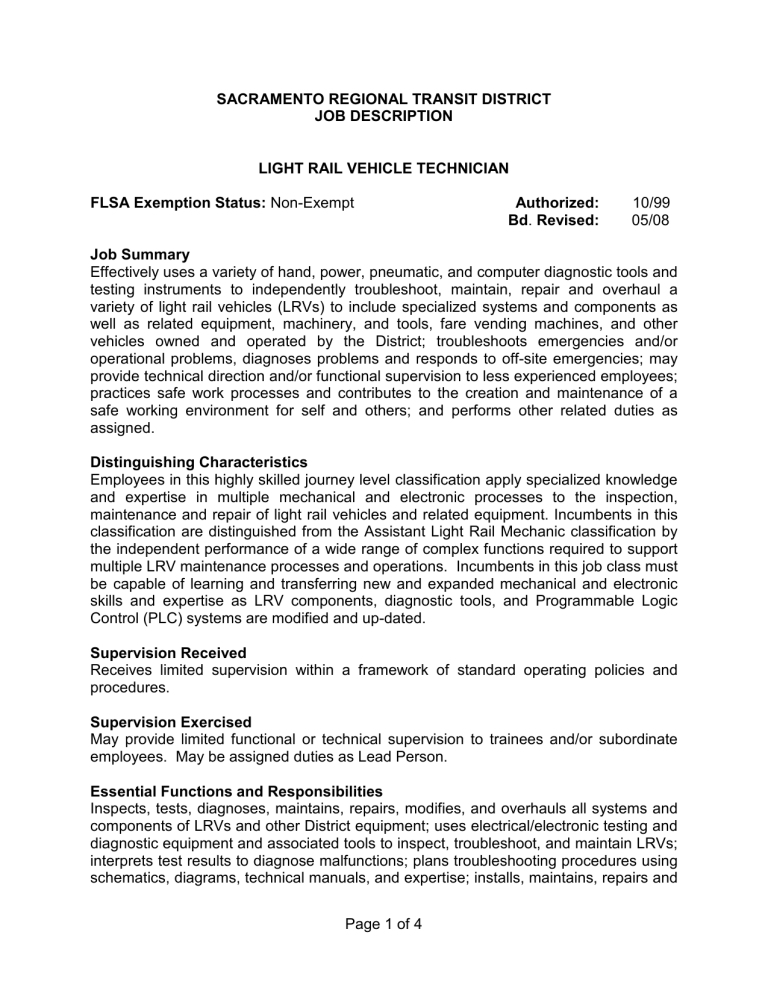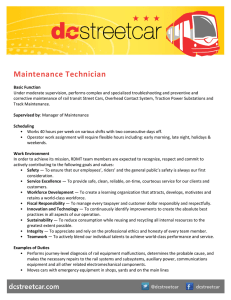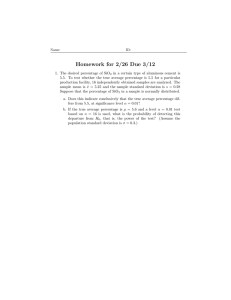Light Rail Vehicle Technician 05-08

SACRAMENTO REGIONAL TRANSIT DISTRICT
JOB DESCRIPTION
LIGHT RAIL VEHICLE TECHNICIAN
FLSA Exemption Status: Non-Exempt Authorized: 10/99
Bd. Revised: 05/08
Job Summary
Effectively uses a variety of hand, power, pneumatic, and computer diagnostic tools and testing instruments to independently troubleshoot, maintain, repair and overhaul a variety of light rail vehicles (LRVs) to include specialized systems and components as well as related equipment, machinery, and tools, fare vending machines, and other vehicles owned and operated by the District; troubleshoots emergencies and/or operational problems, diagnoses problems and responds to off-site emergencies; may provide technical direction and/or functional supervision to less experienced employees; practices safe work processes and contributes to the creation and maintenance of a safe working environment for self and others; and performs other related duties as assigned.
Distinguishing Characteristics
Employees in this highly skilled journey level classification apply specialized knowledge and expertise in multiple mechanical and electronic processes to the inspection, maintenance and repair of light rail vehicles and related equipment. Incumbents in this classification are distinguished from the Assistant Light Rail Mechanic classification by the independent performance of a wide range of complex functions required to support multiple LRV maintenance processes and operations. Incumbents in this job class must be capable of learning and transferring new and expanded mechanical and electronic skills and expertise as LRV components, diagnostic tools, and Programmable Logic
Control (PLC) systems are modified and up-dated.
Supervision Received
Receives limited supervision within a framework of standard operating policies and procedures.
Supervision Exercised
May provide limited functional or technical supervision to trainees and/or subordinate employees. May be assigned duties as Lead Person.
Essential Functions and Responsibilities
Inspects, tests, diagnoses, maintains, repairs, modifies, and overhauls all systems and components of LRVs and other District equipment; uses electrical/electronic testing and diagnostic equipment and associated tools to inspect, troubleshoot, and maintain LRVs; interprets test results to diagnose malfunctions; plans troubleshooting procedures using schematics, diagrams, technical manuals, and expertise; installs, maintains, repairs and
Page 1 of 4
Light Rail Vehicle Technician modifies electrical wiring and equipment such as motors, generators, HVAC climate control units, and related electronic systems; repairs/overhauls hydraulic, pneumatic, and electric brake systems, gear drive units, wheels, bearings, cam shaft controller unit, and other related equipment; replaces and/or repairs accessory parts such as headlights, mirrors, windows, seats, and performs door adjustments; maintains, modifies and repairs fare vending machines; replaces consumables, tests, repairs and modifies electrical, mechanical and electronic systems, including component repair to
Printed Circuit Boards (PCB’s); maintains and repairs re-rail equipment, shop machinery, and power tools, as assigned; energizes and de-energizes the overhead traction power system within the maintenance shop and adjacent yard areas when required for testing, maintenance, and repair of LRVs; operates LRVs in yard or on mainline to safely return LRV to the maintenance facility and to verify performance specifications; line routes, operates and moves LRVs and traction equipment as required for testing, servicing and performing repairs; safely operates a variety of
District vehicles and equipment in the normal performance of duties; as directed, operates re-railing equipment and acts as flag person for the protection of the public, employees and trains during emergencies and rerouting of trains; documents and records work activities such as repairs made, parts usage and work in progress; and performs other related duties as assigned.
Required Education, Experience, Knowledge Skills and Abilities
Any combination of education and experience that would likely provide the required knowledge and abilities is qualifying. A typical way to obtain the knowledge and abilities would be:
Required Prior Education:
High school diploma or equivalent.
Required Prior Experience:
Four (4) years of progressively responsible journey level full-time work experience successfully performing mechanical, electrical, and electronic diagnostic, maintenance and repair functions on large and complex vehicles, machinery and/or equipment; or successful completion of District-sponsored certification and training program. Prior experience working on Light Rail Vehicles or related equipment is highly desirable.
Special Requirements, Licenses and/or Certificates:
Possession of an LRV Mechanic A rating and/or possession of a Regional Transit
Certification of ability to diagnose, repair, and overhaul electrical and mechanical systems for light rail vehicles and other support equipment; possession of a Class A
California Driver’s License permit with endorsement(s) on the first day of appointment, and the ability to obtain a Class A California Driver’s License with endorsement(s) within
90 days of appointment; a satisfactory driving record; possession of a Forklift Operator
Certification or the ability to obtain a forklift certificate within 90 days of appointment, if required; ability to pass and maintain Regional Transit’s examination for LRV Operator’s
License; pass the Ishihara Eye Test; obtain EPA 608 Type 2 Certification within 90 days
Page 2 of 4
Light Rail Vehicle Technician of appointment; required to obtain the tools for the Light Rail Vehicle Technician by the end of the probationary period
Required Knowledge of:
- Methods, materials, tools, and equipment used in the inspection, diagnosis,
- preventive maintenance, overhaul and repair of District LRVs and equipment.
Use of standard tools and equipment common to LRV inspections, maintenance
-
-
- and repair.
Door systems, communication systems (PA, Next stop announcement, passenger information signs (destination/head/next stop signs), and coupler/electrical train line systems
Standard and accepted electronic theory and principles.
Standard and accepted electrical and mechanical systems of Designated District
-
-
-
-
-
Light Rail Vehicles and other related equipment.
Standard and accepted light rail propulsion systems.
Standard and accepted hydraulic, pneumatic, and electric brake systems.
Standard and accepted HVAC systems.
Standard and accepted practices and principles of welding.
Standard first aid and safety practices.
Required Ability to:
- Understand and follow guidelines including the Material Data Safety Sheets
(MSDS) for safe handling of toxic and/or caustic chemicals and other hazardous
-
-
-
-
- materials, including blood borne pathogens .
Obtain and maintain a valid Class A California driver’s license issued by the
Department of Motor Vehicles with proper endorsements and current medical certificate.
Perform critical tasks proficiently and safely and make decisions under stressful conditions
Comply with drug and alcohol testing provisions for safety-sensitive employees as required by the FTA, Department of Transportation (49 CFR, Parts 40 and
655).
Troubleshoot, diagnose, repair and/or overhaul electronic, electrical and mechanical failures for light rail vehicles and heavy equipment.
Inspect, test, adjust, repair, replace, rebuild, and overhaul light rail vehicle equipment, assemblies, sub-assemblies, and related equipment, machinery, tools, and fare vending machines.
-
-
-
-
-
Effectively operate machine tools used in mechanical repair work and use hand tools in making complex repairs to heavy equipment and light rail vehicles.
Demonstrate the correct use of standard hand tools, oscilloscopes, voltmeter, ammeter, ohmmeter, frequency and special generators, and other related tools and equipment.
Understand and effectively follow written and oral instructions.
Learn and effectively apply the District’s policies and procedures.
Prioritize workload to ensure successful job performance for self; and others when training or acting in a lead person capacity.
Page 3 of 4
Light Rail Vehicle Technician
-
-
-
-
-
-
-
Read and understand schematics, operations, service, and safety manuals.
Exercise good judgment and effectively solve practical problems; respond quickly, calmly and appropriately to emergency situations.
Communicate clearly and concisely, both orally and in writing
Write work orders and routine reports in a clear and concise manner.
Calculate basic math, such as proportion, area, volume, and circumference, and apply concepts of basic algebra and geometry.
Safely operate LRVs and District vehicles and equipment.
Establish and maintain effective working relationships with those contacted in the
- performance of required duties.
Perform essential functions of the job without causing harm to self or others
Required Computer Skills with:
- Working knowledge of personal computers and Windows applications.
- Multiple and designated PLC systems used in LRVs and their operations.
- Multiple and designated diagnostic software used to inspect, troubleshoot and diagnose problems in mechanical, electric, and electronic systems.
Physical and Mental Requirements
The essential functions of this job are primarily performed in an open air maintenance facility, though yard and mainline work are performed outside in varying weather conditions. Work is performed on ladders, roof top access platforms and in under vehicle pits, around equipment and machinery with moving parts, and on slippery, uneven surfaces. Incumbents are frequently exposed to risk of electrical shock, airborne particles, vibration, intermittent loud noise, grease and oils; silica; fumes, smoke and gases. Incumbents are occasionally exposed to toxic or caustic chemical fumes, wet conditions, and a fast-paced schedule.
On a daily basis, the essential functions of the job require incumbents to climb ladders, stairs, scaffolding and ramps; to stoop, kneel, crouch, crawl stand, and walk and occasionally to crawl into confined spaces; to extend arms and use upper extremities, finger dexterity and hand strength to reach, pick, pinch and grasp tools and controls and/or to feel the attributes of objects by touch; to lift, and carry objects weighing up to
50 pounds; to push and pull objects weighing up to 150 pounds; to hear and talk to receive and communicate instructions and other information; to rotate neck left and right and bend neck forward and backward; to bend and twist torso; to read and see objects clearly within one foot to twenty feet, requiring a full field of vision and good depth perception with the ability to adjust focus and to distinguish basic colors and shades of color; and to operate vehicles and equipment requiring the use of both feet and hands.
Page 4 of 4



